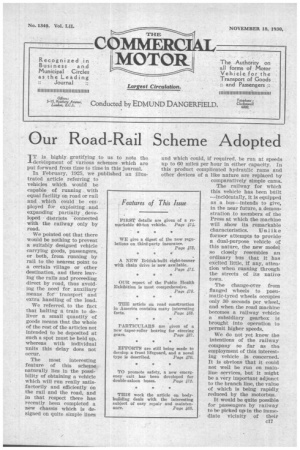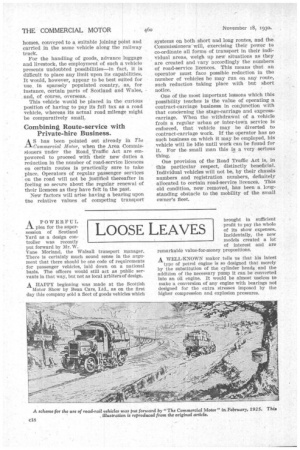Our Road-Rail Scheme Adopted
Page 39

Page 40

If you've noticed an error in this article please click here to report it so we can fix it.
TT is highly gratifying to us to note the 1-development of various schemes which are put forward from time to time in this journal.
capable of running with I equal facility an road or rail a.nd which could be employed for exploiting . and expanding partially developed • districts 'Connected with the railway only by road.
We pointed out that there would be nothing to prevent a suitably designed vehicle carrying goods, passengers, or both, from running by rail to the nearest point to a certain village or other destination, and there leaving the rails and proceeding direct by road, thus avoiding the need for auxiliary means for transport and extra handling of the load.
We referred, to the fact that halting a train to deliver a small quantity of goods means that the whole of the rest of the articles not intended to be deposited at such a spot must be held up, whereas with individual units this delay does not occur.
The most interesting feature of this scheme naturally lies ha the possibility of obtaining a vehicle which will run really satisfactorily and efficiently on the rail and the road, and in that respect there has recently been completed a new chassis which is designed on quite simple lines and which could, if required, be run at speeds up to 60 miles per hour in either capacity. In this product complicated hydraulic rams and other devices of a like nature are replaced by comparatively simple cama.
The railway for which this vehicle has been Iniilt --incidentally, it is equipped as a bus—intends to give, in the near future, a demonstration to members of the Press at which the machine will show its remarkable characteristics. Unlike former attempts to provide a dual-purpose. vehicle of this nature, the new model so closely resembles an ordinary bus that it has excited little, if any, attend t,ion when running through the streets of its native town.
The change-over from flanged wheels to pneumatic-tyred wheels occupies only 30 seconds per wheel, and when the road machine becomes a railway vehicle a subsidiary gearbox is brought into operation to permit higher speeds.
We do not yet know the intentions of the railway company so far as the employment of this interesting vehicle is concerned. It is obvious 'that it could not well be run on mainline services, but it might be a very important adjunct to the branch line, the value of which is being rapidly, reduced by the motorbus.
It would be quite possible for passengers by railway to be picked up in the immediate vicinity of their homes, conveyed to a suitable joining point and carried in the same vehicle along the railway track.
For the handling of goods,. advance luggage and livestock, the employment of such a vehicle presents undoubted possibilities—in fact, it is difficult to place any limit upon its capabilities. It would, however, appear to be best suited for use in sparsely populated country, as, for instance, certain parts of Scotland and Wales, and, of course, overseas. .
This vehicle would be placed in the curious position of having to pay its full tax as a road vehicle, whereas its actual road mileage might be comparatively small.
Combining Route-service with Private-hire Business.
A S has been pointed out already in 7'he -C-I-Commercial Motor, when the Area Commissioners under the Road Traffic Act are empowered to proceed with their new duties a reduction in the number of road-service licences on certain routes is practically sure to take place. Operators of regular passenger services on the road will not be justified thereafter in feeling so secure about the regular renewal of their licences as they have felt in the past.
New factors will arise having a bearing upon tne relative values of competing transport systems on both short and long routes, and the Commissioners will, exercising their power to co-ordinate all forms of transport in their individual areas, weigh up new situations as they are created and vary accordingly the numbers of road-service licences. This means that an operator must face possible reduction in the number of vehicles he may run on any route, such reduction taking place with but short notice.
One of the most important lessons which this possibility teaches is the value of operating a contract-carriage business in conjunction with that concerning the stage-carriage and expresscarriage. When the withdrawal of a vehicle froin a regular urban or inter-town service Is enforced, that vehicle may be diverted to contract-carriage work. If the operator has no such business on which it may be employed, his vehicle will lie idle until work can be found for it. For the small man this is a very serious thing.
One provision of the Road Traffic Act is, in this particular respect, distinctly beneficial. Individual vehicles will not be, by their chassis numbers and registration numbers, definitely allocated to certain road-service licences. This old condition, now removed, has been a longstanding obstacle to the mobility of the small owner's fleet.












































































































